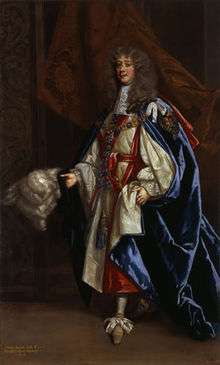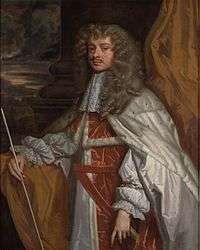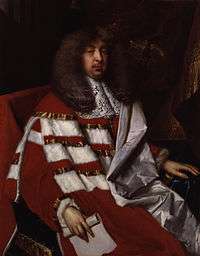Henry Bennet, 1st Earl of Arlington
| The Right Honourable The Earl of Arlington KG, PC | |
|---|---|
 The 1st Earl of Arlington. | |
| Keeper of the Privy Purse | |
| Earl of Arlington | |
| Personal details | |
| Born | 30 January 1618 |
| Died | 28 July 1685 (aged 67) |
| Spouse(s) | Isabella de Nassau |
| Parents |
Sir John Bennet of Dawley, Dorothy Crofts |
| Education | Westminster School |
Henry Bennet, 1st Earl of Arlington KG, PC (1618 – 28 July 1685) was an English statesman.
Background and early life
He was the son of Sir John Bennet of Dawley, Middlesex, by Dorothy, daughter of Sir John Crofts of Little Saxham, Suffolk. He was the younger brother of John Bennet, 1st Baron Ossulston; his sister was Elizabeth Bennet who married Sir Robert Carr (or Kerr). He was baptized at Little Saxham, Suffolk, in 1618, and was educated at Westminster School and Christ Church, Oxford. He gained some distinction as a scholar and a poet, and was originally destined for holy orders. In 1643, he was secretary to Lord Digby at Oxford, and was employed as a messenger between the queen and Ormonde in Ireland. [1]
Subsequently he took up arms for the king, and received a wound on the bridge of his nose in the skirmish at Andover in 1644. The scar resulting from this wound was prominent because Arlington took to covering it with black plaster. After the defeat of the royal cause he travelled in France and Italy, joined the exiled royal family in 1650, and in 1654 became official secretary to James on the recommendation of Charles, who had already been attracted by his "pleasant and agreeable humour."[1] He was said by some to have been the father of an illegitimate child by Lucy Walter.
Knighthood
In March 1657, he was knighted, and the same year was sent as Charles's agent to Madrid, where he remained, endeavouring to obtain assistance for the royal cause, till after the Restoration. On his return to England in 1661 he was made keeper of the privy purse, and became the prime favourite. One of his duties was the procuring and management of the royal mistresses, in which his success gained him great credit. Allying himself with Lady Castlemaine, he encouraged Charles's increasing dislike of Clarendon; and he was made secretary of state in October 1662 in spite of the opposition of Clarendon, who had to find him a seat in parliament. He represented Callington from 1661 till 1665, but appears never to have taken part in debate.[2]
Biography
He served subsequently on the committees for explaining the Irish Act of Settlement and for Tangier. In 1665 he obtained a peerage as Baron Arlington,[3] (properly Harlington, in Middlesex) and in 1667 was appointed one of the postmasters-general. The control of foreign affairs was entrusted to him, and he was chiefly responsible for the attack on the Smyrna fleet and for the Second Anglo-Dutch War, during which he married the beautiful (and, ironically, Dutch) Elisabeth van Nassau-Beverweert (28 December 1633 – 18 January 1718) in March 1665. Elisabeth was the daughter of Louis of Nassau, Lord of De Lek and Beverweerd, the natural son of stadtholder Maurice of Orange. In 1665 he advised Charles to grant liberty of conscience, but this was merely a concession to gain money during the war; and he showed great activity later in oppressing the nonconformists.[1]
Death of Thomas Wriothesley
On the death of Thomas Wriothesley, 4th Earl of Southampton, whose administration he had attacked, his great ambition, the treasurership, was not satisfied; and on the fall of Clarendon, against whom he had intrigued, he did not, though becoming a member of the Cabal Ministry, obtain the supreme influence which he had expected; for Buckingham first equalled, and soon surpassed him, in the royal favour. With Buckingham a sharp rivalry sprang up, and they only combined forces when endeavouring to bring about some evil measure, such as the ruin of the great Ormonde, who was an opponent of their policy and their schemes. Another object of jealousy to Arlington was Sir William Temple, who achieved a great popular success in 1668 by the conclusion of the Triple Alliance; Arlington endeavoured to procure his removal to Madrid, and entered with alacrity into Charles's plans for destroying the whole policy embodied in the treaty, and for making terms with France. He refused a bribe from Louis XIV, but allowed his wife to accept a gift of 10,000 crowns; in 1670 he was the only minister besides the Roman Catholic Clifford to whom the first secret treaty of Dover (May 1670), one clause of which provided for Charles's declaration of his conversion to Romanism, was confided; and he was the chief actor in the deception practised upon the rest of the council.
Personal views
He supported several other measures—the scheme for rendering the king's power absolute by force of arms; the "stop of the exchequer", involving a repudiation of the state debt in 1672; and the Royal Declaration of Indulgence the same year, "that we might keep all quiet at home whilst we are busy abroad." On 22 April 1672 he was created an earl, and on 15 June obtained the Garter; the same month he proceeded with Buckingham on a mission, first to William at The Hague, and afterwards to Louis at Utrecht, endeavouring to force upon the Dutch terms of peace which were indignantly refused, failing to end the Third Anglo-Dutch War. But Arlington's support of the court policy was entirely subordinate to personal interests; and after the appointment of Clifford in November 1672 to the treasurership, his jealousy and mortification, together with his alarm at the violent opposition aroused in parliament, caused him to veer over to the other side.[1]
Declaration of indulgence
He advised Charles in March 1673 to submit the legality of the declaration of indulgence to the House of Lords, and supported the Test Act of the same year, which compelled Clifford to resign. He joined the Dutch party, and in order to make his peace with his new allies, disclosed the secret treaty of Dover to the staunch Protestants Ormonde and Shaftesbury. Arlington had, however, lost the confidence of all parties, and these efforts to procure support met with little success. On 15 January 1674 he was impeached by the Commons, the specific charges being "popery", corruption, and the betrayal of his trust — Buckingham in his own defence having accused him the day before of being the chief instigator of the French and anti-Protestant policy, of the scheme of governing by consent. But the motion for his removal, owing chiefly to the bad influence of his brother-in-law, the popular Lord Ossory, was rejected by 166 votes to 127. His escape could not, however, prevent his fall, and he resigned the secretaryship on 11 September 1674, being appointed lord chamberlain instead. For 1675 he made another attempt to gain favour with the parliament by supporting measures against France and against the Roman Catholics, and by joining in the pressure put upon Charles to remove James from the court. In November he went on a Mission to The Hague, with the popular objects of effecting a peace and of concluding an alliance with William and James's daughter Mary. In this he entirely failed, and he returned home completely discredited.[1]
Treasurership
He had again been disappointed of the treasurership when Danby succeeded Clifford; Charles having declared "that he had too much kindness for him to let him have it for he was not fit for the office." His intrigues with discontented persons in parliament to stir up an opposition to his successful rival came to nothing. From this time, though lingering on at court, he possessed no influence, and was treated with scanty respect. It was safe to ridicule his person and behaviour, and it became a common jest for "some courtier to put black patch upon his nose and strut about with a white staff in a hand in order to make the king merry at his expense." He was appointed a commissioner of the treasury in March 1679, was included in Sir William Temple's new modeled council the same year, and was a member of the inner cabinet which was most immediately formed. In 1681 he was made lord lieutenant of Suffolk. He died on 28 July 1685, and was buried at Euston, where he had bought a large estate and had carried out extensive building operations. [1] His residence in London was Arlington House, built when Goring House burned down, on the site of which was eventually built Buckingham Palace.
Character
Arlington was a typical statesman of the Restoration, possessed outwardly an attractive personality, and according to (Sir William) Temple "the greatest skill of court and the best turns of art of particular conversation," but thoroughly unscrupulous and self-seeking, without a spark of patriotism, faithless even to a good cause, and regarding public office solely as a means of procuring pleasure and profit. His knowledge of foreign affairs and of foreign languages, gained during his residence abroad, was considerable, but long absence from England had also taught him a cosmopolitan indifference to constitutions and religions, and a careless disregard for English public opinion and the prudential interests of the country. According to Clarendon, "He knew no more of the constitution and laws of England than he did of China, nor had he in truth a care or tenderness for church and state, but believed France was the best pattern in the world." He was one of the chief promoters of the attempt to reintroduce into England arbitrary government after the French model, not because he imagined an absolute monarchy essential to the well-being and security of the state, but because under such an administration the favourites of a king enjoyed far greater privileges and profits than under a constitutional government. [1] Like Charles II he was famed for his perfect good manners; Clarendon wrote sourly that this often created an illusion of friendship, of which he was incapable. On the other hand, in a Court famous for sexual licence, he had the reputation of being a good and faithful husband.
Religious beliefs
Of the same egotistical character was his religion, towards which his attitude was similar to that of Charles II himself. He was credited with having inclined the king towards Romanism. Before the Restoration he had attended mass with the king abroad, and in a petition to Lord Bristol had urged Charles to declare publicly his conversion in order to obtain the long-expected succour from foreign powers. But his religion sat lightly upon him as it did upon his master, and it was often convenient to disguise it. Like the king he continued to profess and practise Protestantism, he spent large sums in restoring the church at Euston. Unlike Clifford, he took the Test in 1673 and remained in office, successfully concealing his faith until he "declared himself an adherent of Roman Catholicism" on his deathbed.[1] is I James's statement in Macpherson's Orig. Pap.; Eachard's History of England (1720); Memoirs of W. Temple, ed. by TP Courtenay; C North's Examen, 26; Dalrymple's Mem. (1790); Pepys's Diary (17 Feb. 1663); Cal. of Clarendon St. Pap. iii. 295; Carte's Life of the Duke of Ormonde (1851), iv. 109.
Gallery
- Members of the Cabal Ministry
 Thomas Clifford, 1st Baron Clifford of Chudleigh (1630-1673).
Thomas Clifford, 1st Baron Clifford of Chudleigh (1630-1673). Henry Bennet, 1st Earl of Arlington (1618-1685).
Henry Bennet, 1st Earl of Arlington (1618-1685). George Villiers, 2nd Duke of Buckingham (1628-1687).
George Villiers, 2nd Duke of Buckingham (1628-1687).
 John Maitland, 1st Duke of Lauderdale (1616-1682).
John Maitland, 1st Duke of Lauderdale (1616-1682).
References
- 1 2 3 4 5 6 7 8 Chisholm 1911.
- ↑ Ferris, John P. "History of Parliament Online".
- ↑ Alan Marshall, ‘Bennet, Henry, first earl of Arlington (bap. 1618, d. 1685)’, Oxford Dictionary of National Biography, Oxford University Press, 2004; online edn, Jan 2008.
- Attribution
 This article incorporates text from a publication now in the public domain: Chisholm, Hugh, ed. (1911). "Arlington, Henry Bennet". Encyclopædia Britannica. 2 (11th ed.). Cambridge University Press.
This article incorporates text from a publication now in the public domain: Chisholm, Hugh, ed. (1911). "Arlington, Henry Bennet". Encyclopædia Britannica. 2 (11th ed.). Cambridge University Press.
| Political offices | ||
|---|---|---|
| Preceded by Sir Edward Nicholas |
Secretary of State for the Southern Department 1662–1674 |
Succeeded by Henry Coventry |
| Preceded by The Countess of Chesterfield |
Postmaster General 1667–1685 |
Succeeded by The Earl of Rochester |
| Preceded by The Earl of St Albans |
Lord Chamberlain 1674–1685 |
Succeeded by The Earl of Ailesbury |
| Honorary titles | ||
| Preceded by The Earl of Suffolk |
Lord Lieutenant of Suffolk 1681–1685 |
Succeeded by The Duke of Grafton |
| Peerage of England | ||
| New creation | Earl of Arlington 1672–1685 |
Succeeded by Isabella Bennet |
| Baron Arlington 1665–1685 | ||
| Diplomatic posts | ||
| Preceded by John Digby, 1st Earl of Bristol |
English Ambassador to Spain 1658–1661 |
Succeeded by Sir Richard Fanshawe, 1st Baronet |